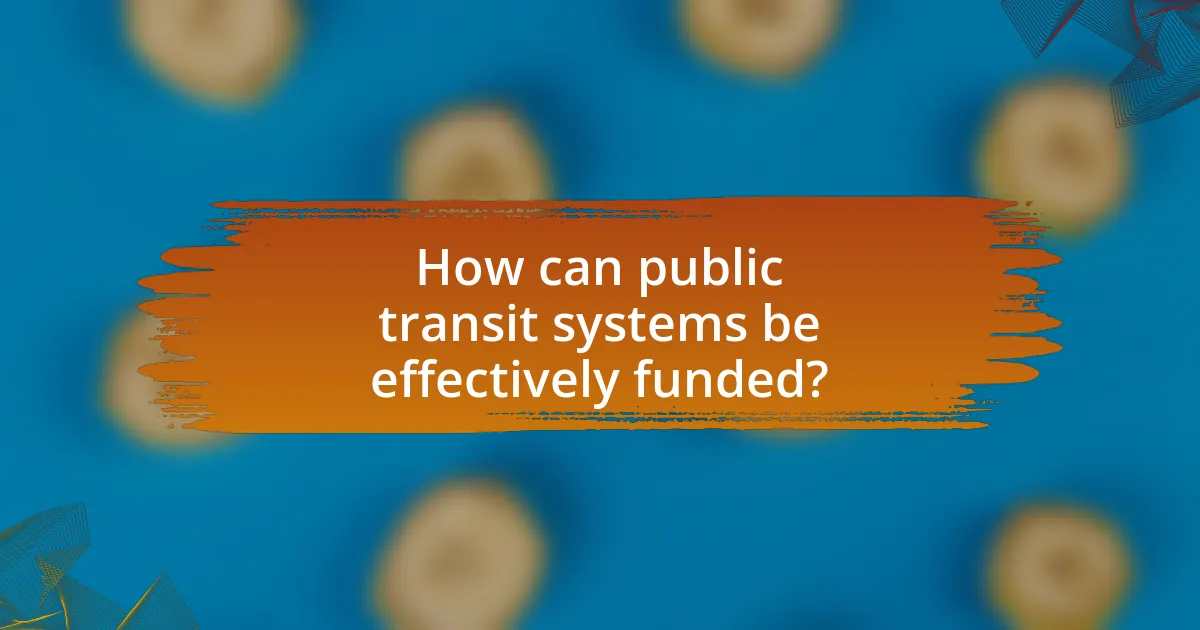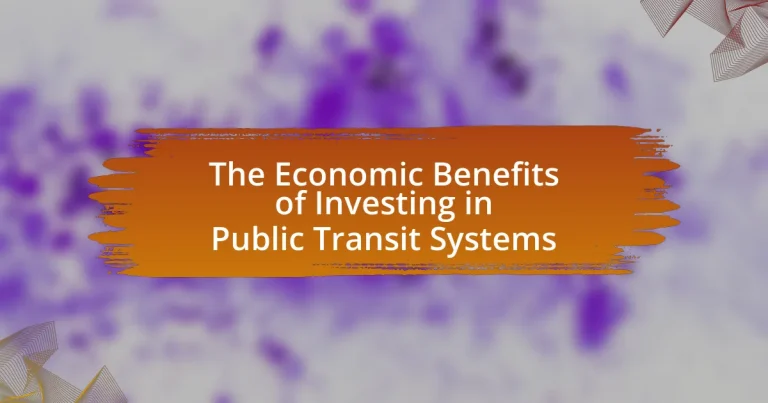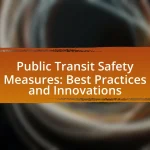The article focuses on the economic benefits of investing in public transit systems, highlighting their role in job creation, increased property values, and enhanced accessibility. It details how public transit investments can stimulate local economies, with every $1 billion invested supporting approximately 50,000 jobs and generating about $4 in economic returns. The article also discusses the direct financial returns from such investments, including higher property values and reduced transportation costs for households. Additionally, it addresses the importance of public transit for urban development, environmental sustainability, and social equity, while exploring funding mechanisms and community involvement in transit projects.

What are the Economic Benefits of Investing in Public Transit Systems?
Investing in public transit systems generates significant economic benefits, including job creation, increased property values, and enhanced accessibility. Public transit projects create jobs not only during construction but also in ongoing operations and maintenance; for instance, the American Public Transportation Association reported that every $1 billion invested in public transit supports approximately 50,000 jobs. Additionally, improved transit options lead to higher property values; studies show that properties near transit stations can appreciate by 10-20% more than those further away. Furthermore, public transit enhances accessibility, allowing individuals to reach employment opportunities more easily, which can boost local economies. These factors collectively demonstrate that investment in public transit yields substantial economic returns.
How does public transit investment impact local economies?
Public transit investment significantly boosts local economies by enhancing accessibility and stimulating job creation. Improved transit systems facilitate easier movement for residents, leading to increased consumer spending in local businesses. For instance, a study by the American Public Transportation Association found that every $1 invested in public transit generates approximately $4 in economic returns. Additionally, transit investments can lead to higher property values and attract new businesses, further contributing to economic growth. This correlation between transit investment and economic vitality underscores the importance of funding and developing public transportation systems.
What are the direct financial returns from public transit investments?
Public transit investments yield direct financial returns primarily through increased property values, enhanced economic activity, and reduced transportation costs. Studies indicate that properties located near transit stations can see value increases of 10% to 30%, as evidenced by research from the National Association of Realtors. Additionally, public transit systems can stimulate local economies by generating jobs; for instance, every $1 invested in public transit can yield approximately $4 in economic returns, according to the American Public Transportation Association. Furthermore, public transit reduces individual transportation costs, saving households an average of $9,000 annually, which can be redirected into the local economy. These financial returns demonstrate the significant economic impact of investing in public transit systems.
How does public transit create jobs in the community?
Public transit creates jobs in the community by stimulating local economies and providing employment opportunities directly and indirectly. When public transit systems are developed or expanded, they require a workforce for construction, maintenance, and operation, leading to immediate job creation. For instance, a study by the American Public Transportation Association found that every $1 billion invested in public transit supports approximately 50,000 jobs. Additionally, improved transit access enhances mobility, allowing residents to reach jobs more easily, which can lead to increased employment rates in the community. This interconnectedness between transit investment and job creation demonstrates the significant economic impact of public transit systems.
Why is public transit essential for urban development?
Public transit is essential for urban development because it enhances accessibility, reduces traffic congestion, and promotes sustainable growth. By providing reliable transportation options, public transit enables residents to reach jobs, education, and services more efficiently, which in turn stimulates local economies. For instance, a study by the American Public Transportation Association found that every $1 invested in public transit generates approximately $4 in economic returns, highlighting its role in fostering urban development. Additionally, cities with robust public transit systems experience lower levels of pollution and reduced dependence on personal vehicles, contributing to a more sustainable urban environment.
How does public transit influence property values?
Public transit positively influences property values by increasing accessibility and desirability of locations near transit stations. Properties located within close proximity to public transit options often see higher demand, leading to increased property values. For instance, a study by the Victoria Transport Policy Institute found that properties near public transit can appreciate by 10% to 30% compared to those further away. This increase is attributed to the convenience and reduced transportation costs associated with easy access to transit, making these areas more attractive to potential buyers and renters.
What role does public transit play in reducing traffic congestion?
Public transit plays a crucial role in reducing traffic congestion by providing an efficient alternative to single-occupancy vehicles. When more people utilize public transit, fewer cars are on the road, which directly decreases the volume of traffic. For instance, a study by the American Public Transportation Association found that public transit use in the United States saves approximately 4.2 billion gallons of gasoline annually, which translates to a significant reduction in the number of vehicles contributing to congestion. Additionally, cities with robust public transit systems, such as New York and San Francisco, experience lower traffic congestion levels compared to those with limited transit options, highlighting the effectiveness of public transit in alleviating traffic issues.
What are the environmental and social benefits associated with public transit investments?
Public transit investments yield significant environmental and social benefits. Environmentally, they reduce greenhouse gas emissions by decreasing reliance on personal vehicles; for instance, public transit can reduce per capita emissions by up to 45% in urban areas. Socially, public transit enhances accessibility, allowing individuals without personal vehicles to reach employment, education, and healthcare, thereby improving overall quality of life. Additionally, studies show that communities with robust public transit systems experience lower poverty rates and increased economic opportunities, as access to transit correlates with higher employment rates.
How does public transit contribute to sustainability efforts?
Public transit contributes to sustainability efforts by reducing greenhouse gas emissions and minimizing reliance on personal vehicles. According to the American Public Transportation Association, public transit saves approximately 45 million metric tons of carbon dioxide annually, which is equivalent to the emissions from over 9 million cars. Additionally, public transit systems promote energy efficiency, as they typically consume less energy per passenger mile compared to individual cars. This shift not only lowers overall energy consumption but also supports urban development that prioritizes walkability and reduced sprawl, further enhancing environmental sustainability.
What social equity benefits arise from improved public transit access?
Improved public transit access enhances social equity by providing marginalized communities with greater mobility and access to essential services. This increased accessibility allows individuals from low-income backgrounds to reach employment opportunities, educational institutions, and healthcare facilities more easily. For instance, a study by the American Public Transportation Association found that public transit can increase job access for low-income individuals by up to 50%, significantly reducing barriers to employment. Additionally, improved transit access can lead to reduced transportation costs, allowing families to allocate more resources toward housing, food, and education, thereby promoting overall economic stability and social inclusion.

How can public transit systems be effectively funded?
Public transit systems can be effectively funded through a combination of government subsidies, fare revenues, public-private partnerships, and dedicated taxes. Government subsidies, such as federal and state grants, provide essential financial support, with the Federal Transit Administration allocating approximately $13 billion annually for public transit projects. Fare revenues contribute to operational costs, while public-private partnerships can leverage private investment for infrastructure development. Additionally, dedicated taxes, such as sales taxes or vehicle registration fees, create a stable funding source; for instance, cities like Los Angeles have successfully implemented a half-cent sales tax to fund transit improvements. These funding mechanisms collectively enhance the sustainability and efficiency of public transit systems.
What funding models are available for public transit projects?
Public transit projects can be funded through various models, including government grants, public-private partnerships (PPPs), fare revenues, and dedicated taxes. Government grants often come from federal or state sources, providing essential capital for infrastructure development. Public-private partnerships leverage private investment to share the financial burden and risks associated with transit projects, allowing for innovative solutions and efficiencies. Fare revenues generated from ticket sales contribute to operational costs, while dedicated taxes, such as sales taxes or property taxes, create a stable funding source specifically earmarked for transit services. These funding models are crucial for the sustainability and expansion of public transit systems, as evidenced by successful implementations in cities like Los Angeles and New York, where diverse funding strategies have supported extensive transit networks.
How do public-private partnerships work in transit funding?
Public-private partnerships (PPPs) in transit funding involve collaboration between government entities and private companies to finance, build, and operate transit projects. In this model, the public sector typically provides regulatory oversight and some funding, while the private sector contributes capital investment, expertise, and operational efficiency.
For instance, in the United States, the Federal Transit Administration has supported PPPs through programs that encourage private investment in public transit infrastructure, leading to projects like the Silver Line in Virginia, which was developed through a PPP model. This approach can reduce the financial burden on taxpayers and leverage private sector innovation, resulting in improved transit services and infrastructure.
What role do government grants and subsidies play in funding public transit?
Government grants and subsidies are crucial for funding public transit, as they provide essential financial resources that enable the development and maintenance of transit systems. These funds help cover operational costs, infrastructure improvements, and capital projects, ensuring that public transit remains accessible and efficient. For instance, in the United States, the Federal Transit Administration allocates billions annually through programs like the Urbanized Area Formula Grants, which support local transit agencies in enhancing their services. This financial support is vital, as it reduces the burden on local governments and taxpayers while promoting sustainable transportation options that benefit the economy and the environment.
Why is community involvement important in funding public transit?
Community involvement is crucial in funding public transit because it ensures that the needs and preferences of local residents are accurately represented and addressed. Engaging the community fosters a sense of ownership and accountability, which can lead to increased public support for funding initiatives. Studies show that transit projects with strong community backing are more likely to secure funding; for instance, a report by the American Public Transportation Association indicates that public support can significantly influence local government decisions on transit funding. Additionally, community input can help identify the most effective transit solutions, leading to better resource allocation and enhanced service efficiency.
How can public opinion shape funding decisions for transit systems?
Public opinion significantly influences funding decisions for transit systems by affecting policymakers’ perceptions and priorities. When a majority of the public expresses support for improved transit services, elected officials are more likely to allocate budgetary resources toward those systems to align with constituents’ demands. For instance, a 2019 survey by the American Public Transportation Association found that 76% of Americans believe public transit is a critical investment for their communities, which can lead to increased political pressure for funding. Additionally, public advocacy campaigns can mobilize community support, leading to successful ballot measures for transit funding, as seen in cities like Los Angeles, where Measure M passed with 71% voter approval, securing billions for transit improvements.
What strategies can be employed to engage the community in funding discussions?
To engage the community in funding discussions for public transit systems, strategies such as hosting community forums, utilizing social media platforms, and forming partnerships with local organizations can be employed. Community forums allow residents to voice their opinions and ask questions, fostering a sense of involvement and ownership in the funding process. Social media platforms can be used to disseminate information quickly and gather feedback, reaching a broader audience. Partnerships with local organizations can enhance credibility and provide additional resources for outreach efforts. These strategies have been shown to increase community participation and support for funding initiatives, as evidenced by successful campaigns in cities like Seattle and San Francisco, where community engagement led to increased funding for transit projects.

What are the challenges and solutions in investing in public transit systems?
Investing in public transit systems faces challenges such as funding shortages, political opposition, and public perception issues. Funding shortages often arise from competing budget priorities, making it difficult to secure necessary financial resources; for instance, the American Public Transportation Association reported that public transit systems in the U.S. face a $90 billion funding gap over the next decade. Political opposition can stem from differing priorities among stakeholders, leading to delays or cancellations of projects. Additionally, public perception issues, including concerns about safety and reliability, can hinder ridership and support for new initiatives.
Solutions to these challenges include diversifying funding sources, engaging in community outreach, and implementing innovative financing mechanisms. Diversifying funding can involve public-private partnerships, grants, and local taxes, which can provide more stable financial support. Community outreach initiatives can help address public concerns and build support for transit projects, as seen in successful campaigns in cities like Seattle, where public engagement increased support for transit expansion. Innovative financing mechanisms, such as value capture financing, can leverage increased property values near transit stations to fund improvements, as demonstrated in cities like San Francisco.
What common obstacles do cities face when investing in public transit?
Cities commonly face funding constraints when investing in public transit, which limits their ability to develop and maintain effective systems. Budgetary limitations often arise from competing priorities such as education and healthcare, leading to insufficient financial resources allocated for transit projects. Additionally, political challenges, including differing opinions among stakeholders and the need for public support, can hinder decision-making processes. For instance, a study by the American Public Transportation Association indicates that 70% of transit agencies report funding as a significant barrier to expanding services. Furthermore, regulatory hurdles and lengthy approval processes can delay project implementation, complicating efforts to enhance public transit infrastructure.
How can political opposition impact public transit projects?
Political opposition can significantly delay or derail public transit projects by influencing funding decisions and legislative support. When political leaders or parties oppose a transit initiative, they may mobilize public sentiment against it, leading to reduced political will and funding from government bodies. For instance, in 2018, the proposed transit expansion in Los Angeles faced opposition from certain political factions, resulting in a delay of over a year in project timelines and increased costs due to inflation. This demonstrates that political opposition not only affects the immediate progress of public transit projects but can also escalate overall expenses and hinder long-term planning and implementation.
What are the financial risks associated with public transit investments?
Public transit investments carry several financial risks, including cost overruns, revenue shortfalls, and changes in government funding. Cost overruns can occur due to unforeseen construction challenges or inflation, leading to budgets exceeding initial estimates; for example, the San Francisco Bay Area’s Transbay Transit Center faced a cost increase from $1.6 billion to over $2.2 billion. Revenue shortfalls may arise if projected ridership does not materialize, as seen in the case of the Los Angeles Metro, which experienced lower-than-expected fare revenues. Additionally, reliance on government funding can pose risks, as political shifts may lead to reduced financial support, impacting project viability and sustainability.
What innovative solutions exist to overcome these challenges?
Innovative solutions to overcome challenges in public transit systems include the implementation of smart technology, such as real-time tracking and mobile payment systems. These technologies enhance user experience and operational efficiency by providing accurate information on transit schedules and enabling seamless fare payments. For instance, cities like San Francisco have adopted mobile apps that allow users to track buses in real-time, leading to increased ridership and reduced wait times. Additionally, integrating electric and autonomous vehicles into public transit fleets can lower operational costs and improve environmental sustainability. Research from the American Public Transportation Association indicates that every $1 invested in public transit generates approximately $4 in economic returns, highlighting the financial viability of these innovative solutions.
How can technology improve the efficiency of public transit systems?
Technology can improve the efficiency of public transit systems by enabling real-time tracking and data analytics. Real-time tracking allows transit agencies to monitor vehicle locations and passenger loads, leading to optimized routing and scheduling. For instance, cities that have implemented GPS tracking systems have reported a reduction in wait times by up to 20%, as buses and trains can adjust their schedules based on actual demand. Additionally, data analytics can identify patterns in ridership, allowing for better resource allocation and service adjustments. A study by the American Public Transportation Association found that systems utilizing advanced technology saw a 15% increase in ridership, demonstrating the direct impact of technology on operational efficiency.
What best practices can cities adopt to ensure successful transit investments?
Cities can adopt several best practices to ensure successful transit investments, including comprehensive planning, community engagement, and performance measurement. Comprehensive planning involves integrating transit investments with land use and economic development strategies, which can enhance accessibility and stimulate local economies. Community engagement ensures that the needs and preferences of residents are considered, leading to higher usage rates and public support. Performance measurement allows cities to assess the effectiveness of transit systems, enabling data-driven adjustments and improvements. For instance, cities like Portland have successfully implemented these practices, resulting in increased ridership and economic growth, demonstrating the tangible benefits of strategic transit investments.
What practical steps can communities take to advocate for better public transit?
Communities can advocate for better public transit by organizing grassroots campaigns to raise awareness and support for transit initiatives. These campaigns can include public meetings, surveys to gather community input, and partnerships with local businesses to demonstrate the economic benefits of improved transit. For instance, a study by the American Public Transportation Association found that every $1 invested in public transit generates approximately $4 in economic returns, highlighting the financial advantages of advocacy efforts. Additionally, communities can engage with local government officials to push for policy changes and funding allocations that prioritize transit improvements, ensuring that public transit becomes a key component of urban planning and development strategies.


